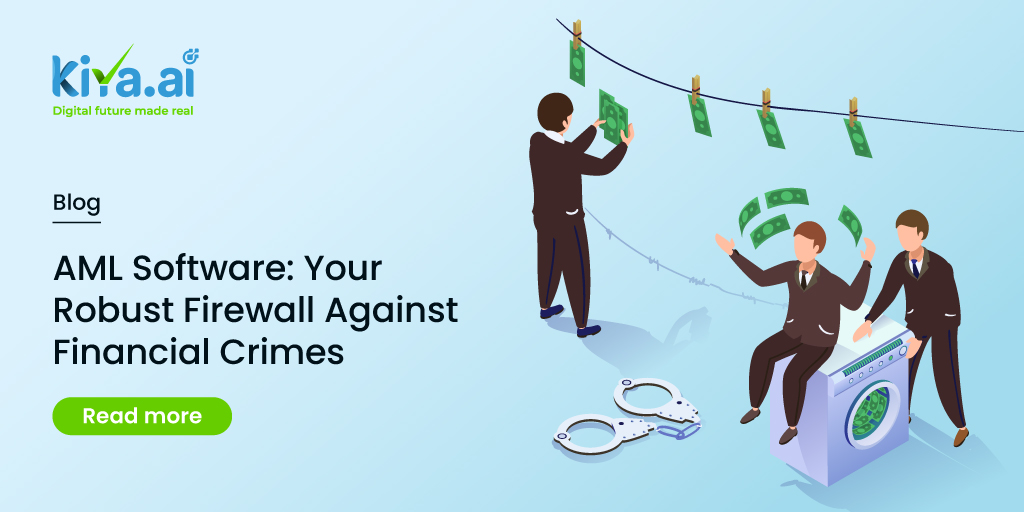AML Software: Your Robust Firewall Against Financial Crimes

Money laundering poses a pervasive threat to the global financial ecosystem, casting shadows on its integrity and stability. The United Nations estimates that nearly 5% of the global GDP, a staggering $800 billion, succumbs to money laundering annually. The ramifications are clear – financial institutions must fortify their defences against this insidious practice.
Businesses face numerous challenges in achieving AML compliance, including regulatory intricacies, data management challenges, managing false positives, efficient resource allocation, and navigating the evolving threat landscape. Moreover, challenges extend to evolving AML regulations and compliance, complexities with customer due diligence (CDD) and Know Your Customer (KYC) processes, transaction monitoring challenges, and technological hurdles in compliance. Along with this, cross-border transactions further complicate AML efforts, as tracking payments between countries becomes increasingly challenging in a global business environment.
Enters Anti-Money Laundering (AML) software, the guardians of financial integrity. With the mission to prevent, detect, and report money laundering activities, this software is indispensable for businesses striving to protect their reputation, steer clear of fines and penalties, and actively combat financial crime.
The AML software market, a vital player in this arena, has witnessed remarkable growth, reaching $1.63 billion in 2021 and projecting to soar to $7.64 billion by 2032.
Let’s unravel the essence of AML software – exploring its pivotal features and demystifying the step-by-step process of its development.
AML Compliance Software:
In the realm of Anti-Money Laundering (AML) compliance, specialised software plays an important role for businesses striving to fulfil their obligations under AML requirements. Mandated to establish robust procedures for identifying and combating fraud and money laundering activities, businesses leverage AML compliance software for seamless automation. This transformative technology encompasses key functions such as customer due diligence, transaction monitoring, risk assessment, and recordkeeping. The Know Your Customer (KYC) facet involves automated identity verification and screening against watch lists, streamlining the customer identification process. Transaction monitoring, a crucial fraud detection mechanism, employs safe algorithms to analyse patterns and outliers, flagging suspicious activity in real-time.
AML compliance software is instrumental in risk assessment, evaluating factors like the nature of the customer’s business and the source of funds. Furthermore, it addresses regulatory recordkeeping requirements, providing businesses with a centralised storage facility for meticulous records of customers, transactions, and due diligence activities.
The adoption of Anti-Money Laundering (AML) compliance software emerges as a strategic imperative for businesses, offering a myriad of benefits that profoundly impact their profitability, success, and reputation.
Risk Mitigation:
AML software serves as a formidable defence against financial threats by identifying and halting suspicious transactions early on. The software empowers companies to measure risks accurately in real-time and develop effective preventative strategies against the ever-evolving threats of money laundering, ensuring a secure corporate sector.
Guarding Against Reputational Damage:
Reputational damage, a severe consequence of money laundering, poses a significant risk to businesses. AML software becomes a shield, demonstrating a commitment to legality and compliance with AML regulations. By actively preventing illicit activities, businesses protect their brand reputation, fostering trust among customers, partners, and stakeholders.
Avoidance of Legal and Regulatory Penalties:
Failure to adhere to AML regulations can result in various legal and regulatory penalties. AML software equips enterprises with the necessary means and procedures to ensure compliance, minimising the likelihood of non-compliance-related penalties. By demonstrating robust systems to counter money laundering, businesses safeguard themselves from legal repercussions.

Enhanced Due Diligence:
The AML software allows institutions with the ability to verify customer identities, screen individuals and entities against watchlists, and assess the risk associated with different customers. This ensures that institutions have a thorough understanding of their customers and can make informed decisions about the level of risk they represent.
Efficient Recordkeeping:
AML software facilitates meticulous recordkeeping, addressing the business requirement for proper documentation of clients, transactions, and customer due diligence. Records are centralised and easily accessible, ensuring seamless compliance with stipulations and enhancing the overall record-keeping process.
Automation and Burden Reduction of Compliance:
AML regulations can be arduous and time-consuming. AML software automates most compliance procedures efficiently, relieving businesses and their employees from the burden of manual compliance. This streamlining allows businesses to allocate resources to other critical areas, optimising their operational efficiency.
Global Operations:
Since different countries have distinct AML regulations, robust AML software is crucial for managing compliance across multiple jurisdictions. With its ability to generate Suspicious Activity Report (SAR), accurate AML Risk Assessment and efficient Regulatory Technologies, the software helps institutions navigate and adhere to diverse global regulatory environments.

Money laundering poses a pervasive threat to the global financial ecosystem, casting shadows on its integrity and stability. The United Nations estimates that nearly 5% of the global GDP, a staggering $800 billion, succumbs to money laundering annually. The ramifications are clear – financial institutions must fortify their defences against this insidious practice.
Businesses face numerous challenges in achieving AML compliance, including regulatory intricacies, data management challenges, managing false positives, efficient resource allocation, and navigating the evolving threat landscape. Moreover, challenges extend to evolving AML regulations and compliance, complexities with customer due diligence (CDD) and Know Your Customer (KYC) processes, transaction monitoring challenges, and technological hurdles in compliance. Along with this, cross-border transactions further complicate AML efforts, as tracking payments between countries becomes increasingly challenging in a global business environment.
Enters Anti-Money Laundering (AML) software, the guardians of financial integrity. With the mission to prevent, detect, and report money laundering activities, this software is indispensable for businesses striving to protect their reputation, steer clear of fines and penalties, and actively combat financial crime.
The AML software market, a vital player in this arena, has witnessed remarkable growth, reaching $1.63 billion in 2021 and projecting to soar to $7.64 billion by 2032.
Let’s unravel the essence of AML software – exploring its pivotal features and demystifying the step-by-step process of its development.
AML Compliance Software:
In the realm of Anti-Money Laundering (AML) compliance, specialised software plays an important role for businesses striving to fulfil their obligations under AML requirements. Mandated to establish robust procedures for identifying and combating fraud and money laundering activities, businesses leverage AML compliance software for seamless automation. This transformative technology encompasses key functions such as customer due diligence, transaction monitoring, risk assessment, and recordkeeping. The Know Your Customer (KYC) facet involves automated identity verification and screening against watch lists, streamlining the customer identification process. Transaction monitoring, a crucial fraud detection mechanism, employs safe algorithms to analyse patterns and outliers, flagging suspicious activity in real-time.
AML compliance software is instrumental in risk assessment, evaluating factors like the nature of the customer’s business and the source of funds. Furthermore, it addresses regulatory recordkeeping requirements, providing businesses with a centralised storage facility for meticulous records of customers, transactions, and due diligence activities.
The adoption of Anti-Money Laundering (AML) compliance software emerges as a strategic imperative for businesses, offering a myriad of benefits that profoundly impact their profitability, success, and reputation.
Risk Mitigation:
AML software serves as a formidable defence against financial threats by identifying and halting suspicious transactions early on. The software empowers companies to measure risks accurately in real-time and develop effective preventative strategies against the ever-evolving threats of money laundering, ensuring a secure corporate sector.
Guarding Against Reputational Damage:
Reputational damage, a severe consequence of money laundering, poses a significant risk to businesses. AML software becomes a shield, demonstrating a commitment to legality and compliance with AML regulations. By actively preventing illicit activities, businesses protect their brand reputation, fostering trust among customers, partners, and stakeholders.
Avoidance of Legal and Regulatory Penalties:
Failure to adhere to AML regulations can result in various legal and regulatory penalties. AML software equips enterprises with the necessary means and procedures to ensure compliance, minimising the likelihood of non-compliance-related penalties. By demonstrating robust systems to counter money laundering, businesses safeguard themselves from legal repercussions.

Enhanced Due Diligence:
The AML software allows institutions with the ability to verify customer identities, screen individuals and entities against watchlists, and assess the risk associated with different customers. This ensures that institutions have a thorough understanding of their customers and can make informed decisions about the level of risk they represent.
Efficient Recordkeeping:
AML software facilitates meticulous recordkeeping, addressing the business requirement for proper documentation of clients, transactions, and customer due diligence. Records are centralised and easily accessible, ensuring seamless compliance with stipulations and enhancing the overall record-keeping process.
Automation and Burden Reduction of Compliance:
AML regulations can be arduous and time-consuming. AML software automates most compliance procedures efficiently, relieving businesses and their employees from the burden of manual compliance. This streamlining allows businesses to allocate resources to other critical areas, optimising their operational efficiency.
Global Operations:
Since different countries have distinct AML regulations, robust AML software is crucial for managing compliance across multiple jurisdictions. With its ability to generate Suspicious Activity Report (SAR), accurate AML Risk Assessment and efficient Regulatory Technologies, the software helps institutions navigate and adhere to diverse global regulatory environments.
